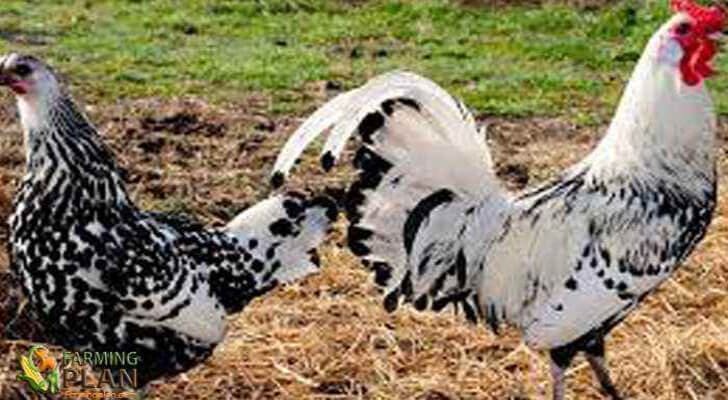The Polish Chicken according to Darwin, would be originally from Poland. Anyway, the origin remains uncertain and is associated not only with the polish chicken but also with the Dutch with tuft but without the beard. In numerous quotations from the sixteenth century, there is the existence of a particularly productive and famous breed of chickens from the Padua area.
The decline of the polish chicken race began as early as the 19th century. At the beginning of the 20th century, there were still a few thousand, but in the 1960s they disappeared almost completely. Medium-sized poultry, also known as Dutch hen or crested Dutch.

Characteristics of Polish Chicken
The Polish Chicken has a solid appearance, strong legs and strong nails, short and broad wings, strong beaks, and a little curved and colorful plumage. Furthermore, this species often have ridges and chin and feed on grain. They can live up to 7 years. Almost The male reaches sexual maturity at six-seven months. While the female at five-six.
Roosters of this species maintain a weight between 1.8 and 2.3 kg. While hens weigh between 1.5 and 2.0 kg. The body of medium length, upright posture. The trunk is slightly elongated and sloping, widens at shoulder height and narrows toward the hips.
The hen is more compressed and lower and has a more horizontal bearing than the cock. The head, medium in size, has a highly developed cranial hernia and a bulging plume. The beak is strong, slightly arched, with large nostrils. The color changes according to the color of the hen. The eyes are large, round, lively, brown, except in the white hen and in the Sparrow hen, where they are orange.
No crest, the presence of small fleshy protuberances should not be considered a defect. No chin, or barely perceptible, hidden by the beard. The face is red, covered with a dense beard. Small ears fully covered by beard and plume. The beard and sideburns are well evident, with adherent plumage.
In the cock, the plume is dense and has a globe shape, down, narrow and pointed feathers surround the head from behind and laterally. The underlying and front feathers hold the tuft. In the hen, the plume is spherical, large, dense, firm and non-hanging. The plume should not prevent visual in either sex. a Mid-length collar with abundant plumage. Shoulders are wide and round. You May Also Like To Read Cornish Chicken.
The back of the medium length inclines slightly towards the hips, endowed with abundant feathers. Wings of medium length, horizontal and adherent to the body. Tail dense, half-open in the hen, broad in the cock, with well-arched sickles. The angle of the tail is 40-45 ° in the cock and 30-35 ° in the hen. The chest is round, dense and tall.
Also, the legs are of medium length, with and feathers. The tarsi are of medium length, fine, without feathers and of four fingers. Its color varies according to the coloration of the hen. The belly is smooth and well developed. In addition, this species has various colorations: Silver black edged, White, Blue edged, White, edged chamois, Pearl gray, Black, Black edged gold, Hawk, Tricolor.
Food
The Food of The Polish chicken must contain, necessarily water, foods that provide protein, energy, minerals, and vitamins. Otherwise, the animals will grow little, produce little meat and eggs and many will become ill and die.
Defects
Especially relevant the serious defects of this species are too low or too high posture, weak trunk with pointed chest, plume too small, open, dropped or crooked, not well-developed beard, very evident ridge, chin or Ears visible. A very serious defect that can be found often is the presence of white feathers in the tuft of the color varieties (especially in the black and gold variety).
Usage
The Polish Chicken’s usefulness is dual purpose. As a result, its meat is lean, of white color pink and delicate flavor. Females have very poor ability to behave. Generally, it is raised in purity or for the production of eggs. Light, elegant, vivacious and ornamental chicken; Trustworthy character. In addition, this species is shown in exhibitions by the feathers that it has in its head of so peculiar form. And how attractive they are. You May Also Like To Read Red Shaver Chicken.
Special Feature
The body temperature of the polish chicken is 40 °C, due to the coating of feathers, because they lack sweat glands. They can use up to 1 hour for their thermal control. Generally is it is advisable to cut the peak at 10 days of birth to reduce cannibalism, picking, and plucking, which may be due to boredom by confinement. Like reptiles, hens have scales on their paws.
The polish chicken has a protuberance in the skull, and all members of this species are born with this same characteristic. And although all the members possess this formation in the cranium, in the same place, the only thing that varies is the size.
The degree to which ossify the protuberance varies greatly, being larger or smaller portions of bone being arrive to replace with the membrane. The brain of the polish chicken is modified, it is much larger than that of other species, but laterally it is less deep. And although the brain of this species is large, it does not completely fill the cavity of the skull.
Conclusion
In this guide, we have shared with you the history of the Polish crested chicken breed as well as their physical characteristics. If you are interested in adding these birds to your flock or just want a better understanding of how they came about, be sure to read on! Good luck and happy raising!
As A References: Wikipedia


